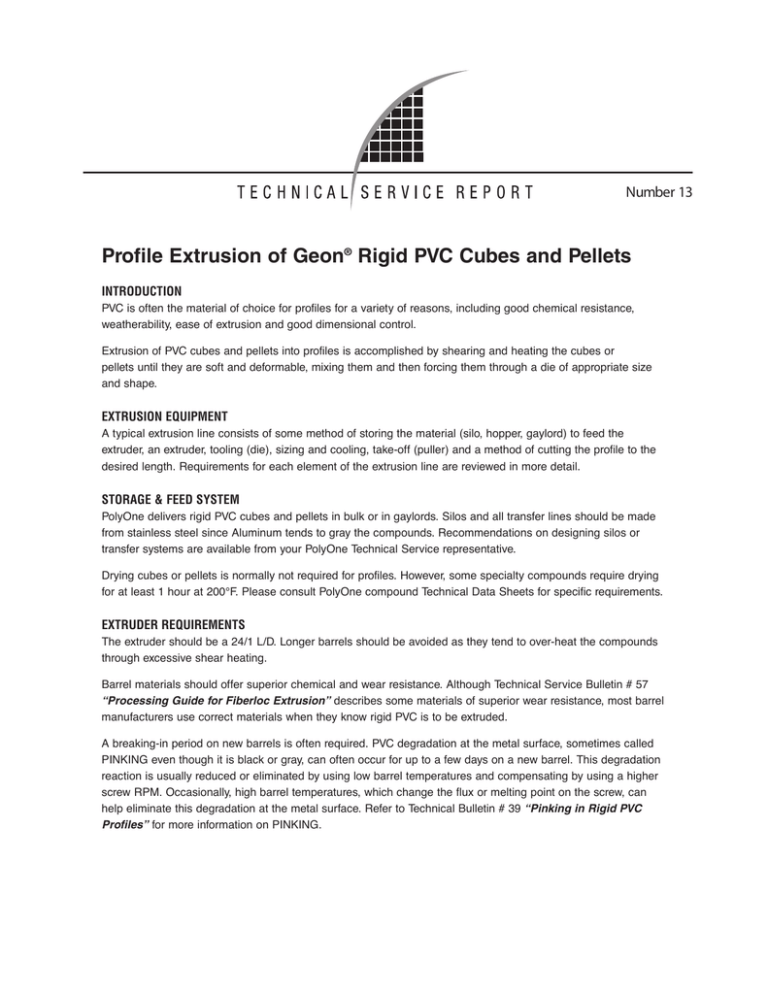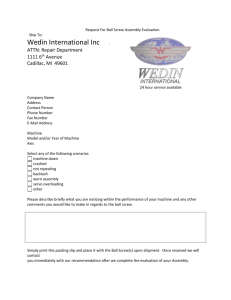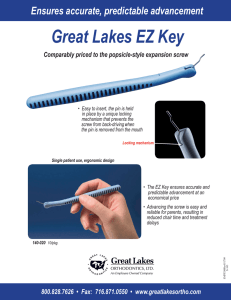
Number 13
Profile Extrusion of Geon® Rigid PVC Cubes and Pellets
INTRODUCTION
PVC is often the material of choice for profiles for a variety of reasons, including good chemical resistance,
weatherability, ease of extrusion and good dimensional control.
Extrusion of PVC cubes and pellets into profiles is accomplished by shearing and heating the cubes or
pellets until they are soft and deformable, mixing them and then forcing them through a die of appropriate size
and shape.
EXTRUSION EQUIPMENT
A typical extrusion line consists of some method of storing the material (silo, hopper, gaylord) to feed the
extruder, an extruder, tooling (die), sizing and cooling, take-off (puller) and a method of cutting the profile to the
desired length. Requirements for each element of the extrusion line are reviewed in more detail.
STORAGE & FEED SYSTEM
PolyOne delivers rigid PVC cubes and pellets in bulk or in gaylords. Silos and all transfer lines should be made
from stainless steel since Aluminum tends to gray the compounds. Recommendations on designing silos or
transfer systems are available from your PolyOne Technical Service representative.
Drying cubes or pellets is normally not required for profiles. However, some specialty compounds require drying
for at least 1 hour at 200°F. Please consult PolyOne compound Technical Data Sheets for specific requirements.
EXTRUDER REQUIREMENTS
The extruder should be a 24/1 L/D. Longer barrels should be avoided as they tend to over-heat the compounds
through excessive shear heating.
Barrel materials should offer superior chemical and wear resistance. Although Technical Service Bulletin # 57
“Processing Guide for Fiberloc Extrusion” describes some materials of superior wear resistance, most barrel
manufacturers use correct materials when they know rigid PVC is to be extruded.
A breaking-in period on new barrels is often required. PVC degradation at the metal surface, sometimes called
PINKING even though it is black or gray, can often occur for up to a few days on a new barrel. This degradation
reaction is usually reduced or eliminated by using low barrel temperatures and compensating by using a higher
screw RPM. Occasionally, high barrel temperatures, which change the flux or melting point on the screw, can
help eliminate this degradation at the metal surface. Refer to Technical Bulletin # 39 “Pinking in Rigid PVC
Profiles” for more information on PINKING.
Drive motors should have adequate horsepower and be geared for high torques at relatively low RPM’s,
ie 35 max.
Extruder size
2 1/2" or 50 mm
3 1/2" or 90 mm
4 1/2" or 110mm
Recommended
Horsepower
40
75
100
Oil cooling or high capacity air blowers with finned heaters are preferred on barrels with a deep thermocouple
control system. A pressure gauge should be located at the end of the barrel.
SCREW DESIGN
A good general-purpose screw design is one with a single flight, constant pitch with the pitch equal to the
diameter, and length equal to 24 diameters. It should be bored for potential screw cooling. Screw flights should
be flame hardened or capped with Colmonoy 56 or other suitable treatments for rigid PVC. The screw should be
chrome plated. The following designs will produce good results under a variety of conditions. It should be noted
that other screw designs work as well.
Flights
Diameter in/mm
Feed
Transition
Metering
Pounds/hr
2 1/2 - 60
5 @ 0.500"
7
12 @ 0.210"; 4 rows of pins*
50-80
3 1/2 - 90
5 @ 0.625"
7
12 @ 0.260"; 4 rows of pins*
80-300
4 1/2 - 110
5 @ 0.770"
7
12 @ 0.320"; 4 rows of pins*
150-500
• Typical pin placement: on a 3 1/2" screw for each row, use 27 pins made of 304/SS, 5/32" diameter on
a 36 hole index. Press fit into 1/4" deep holes and grind to screw diameter. DO NOT interrupt the screw
flight. Place the four rows of pins at 3, 6, 9 and 12 flights from the screw tip. Use 1/8" diameter pins on
a 30 hole index on a 2 1/2" extruder and 5/32" diameter pins on a 43 hole index for a 4 1/2" extruder.
Again, DO NOT interrupt the screw flight.
Regardless of the screw size, a 2.4:1 compression ratio is recommended for rigid PVC. This is the ratio of the
channel depth in the feed zone to the exit depth in the metering zone. Higher compression screws, such as
those designed for flexible PVC, can cause over-heating of the material. In extreme cases, the use of a high
compression screw can lead to burning of the rigid PVC compound.
Constant taper screws, where the flight depth decreases at a constant rate from the first flight to the last flight,
are also to be avoided. There is usually inadequate mixing within a given flight to maximize melt temperature
uniformity. This can lead to variations in melt temperature at the approach to the die, which in turn can affect
melt flow stability.
Badly worn screws, where the total clearance exceeds about 0.030”, can result in over-heating of the PVC
compound. This is because the pressure along the screw is sufficient to drive material backwards over the
wider than normal gap between screw flight and barrel. The residence time increases within the barrel and the
extra shearing causes the melt temperature to rise. The most common indicator of a worn barrel is a significant
reduction in output at a given screw speed.
TWIN SCREWS
Special low shear screws are available for cube or pellet extrusion on twin screw extruders. Care should be
exercised to avoid over-amping the extruder. Usually, this can be accomplished by starve feeding the cubes or
pellets into the feed throat.
BREAKER PLATES AND SCREEN PACKS
Breaker plates are required to prevent the melt from twisting in the die and thus avoiding swirls in the profile.
They also support the screen packs, which are recommended.
Use breaker plates made from Armco 17-4PH, 15-5PH, Carpenter Cartech Custom 450, or other suitable
chemically resistant materials. They should be hardened and polished. Holes should be between 1/8" to 3/16"
in diameter. Smaller holes can cause over-heating; larger holes can allow the screens to collapse in them. The
entrance and exit of each hole should be chamfered to avoid stagnation. Avoid using carbon steel, simple
because of its poor chemical resistance. Also avoid using Aluminum or brass, which can lead to degradation of
the PVC. Crossover breaker plates have been known to help if PINKING is a problem.
Screens should be stainless steel. If multiple screens are used, always place the coarser screen downstream
to back up the finer ones. A 20/40-mesh combination is usually sufficient.
DIES
Flat plate dies are usually adequate for short runs of about 6 hours or less at low melt temperatures. However,
for longer run lengths, all sections of the die and adaptor should be streamlined to prevent stagnation and
degradation.
Without going into the specifics of die design, the following are some guidelines:
• Transitions in the adaptor should be smooth with approach angles of 30° or less.
• The melt inventory behind the lips should be kept low by making the adaptor as short as possible.
However, if swirling is observed in the melt, due to non-homogeneity off the screw, then the adaptor
might need to be slightly larger.
• The critical element in die design is to get all sections of the melt moving out of the die at the same
velocity. This is accomplished by adjusting the land length behind the die lips to balance pressure flow.
• Land length should be about 10-15:1 or as low as 8:1 for very thin profiles.
• Dies should be balanced for one compound at one temperature on one size of extruder, and ideally
with one screw design.
Die materials must be chosen for corrosion resistance and durability. It is common to use softer metals that
can be easily machined but which can be subsequently hardened for durability. Good die materials would be
AISI-SAE 0-6 or A-6, hardened after machining and then chrome plated. Alternate materials not requiring
chrome plating would be stainless steels such as Armco 17-4PH, Armco 15-5PH or Carpenter Cartech Custom
450, hardened after machining and finally polished. There are many other materials that can be used
successfully, provided they are chosen for good chemical resistance and are easily machined. Aluminum,
brass and Copper dies, spacers, etc are not recommended since they are reactive with PVC and can cause
burning of the compound.
COOLING AND SIZING
Profile cooling and sizing can be accomplished by using a combination of vacuum sizers, finger sizers, air-cooling, water immersion or water spray. The exact combination is determined by the ultimate cooling and shaping
requirements of the extruded profile.
PULLERS AND CUTTERS
Profiles must be pulled down the line using a constant tension and constant speed puller. Variations in puller
speed will cause dimensional variations which will jam vacuum sizers.
Profiles can be cut using a sharp high speed saw, a fly knife or guillotine cutter prior to packaging.
Trouble Shooting Guide for Profile Extrusions
Made with Rigid Geon® Vinyls
Problem
Typical Cause
Suggestive Corrective Action
Orange Peel,
Alligator Skin
Too much fusion
Reduce melt temperature
Reduce Rate
Increase die temperature
Increase melt temperature
Check for proper screw/barrel fit
Small Chunks
Too little fusion
Increase screw RPM
Use tighter screen pack
Check for proper screw/barrel fit
Poor regrind quality
Use correct compound
Use sharp blades in grinder
Cool regrind properly
Check for contamination
Run 10°F hotter than 100% virgin
Sandpaper Finish
Sticking in die
Reduce die temperature
Reduce melt temperature
Chrome die land
Polish die
Swirls
Melt flow problems
Use breaker plate
Use pins on screw
Reduce barrel temperature
Reduce rate
Increase inventory behind die lips to allow thermal uniformity
Check for proper screw and barrel fit
Colored Streaks
Degradation
Break in new barrel or screw
Refer to TSB #13 for equipment recommendations
Reduce barrel temperatures
Increase barrel temperatures
Use converging/diverging breaker plate
Sizer wear
Use anodized aluminum or stainless steel
Reduce vacuum in sizer
Incomplete dispersion of
color concentrate
Use correct screw design
Check compatibility of color concentrate and compound
Use precolored compound
Degradation in center of profile
(colored line down center)
Use screw cooling
Use offset screw tip
Allow 1/2" clearance between screw tip and breaker plate
Dull Surface
Low temperature
Increase melt temperature
Increase screw RPM
Polish and chrome plate die
Check compound selection
Bubbles
Moisture
Dry the cubes/pellets
Decrease rear zone temperature
Trapped Air
Decrease rear zone temperature
Degradation
Reduce melt temperature
Check barrel, screw and die temperature controls
Problem
Typical Cause
Suggestive Corrective Action
Die Lines
Nicked die/approach
Polish Die
Use brass tools during cleaning
Remove scratches/gouging in adapter
Plate-out
See plate-out
Dirt Attraction
Static
Pass profile through 5% soap solution
Edge tear
Uneven velocity across profile
Increase die temperature
Increase RPM
Increase melt temperatures
Radius inside corners
Avoid blowing air on die
Use finer screens
Contamination
Eliminate contamination
Build-Up in Die (Plate-out)
Compound ingredient sticking to metal Reduce head pressure
Reduce die land length
Chrome plate adapter
Polish adapter
Check compound selection
High Head Pressure
Long Die Land
High Drive Motor Amps
Reduce land length
Using restrictor
Eliminate restrictor
High melt viscosity
Increase melt temperature
Check temperature controls
Use lower viscosity compound
Improper breaker plate and/or
screen pack
Change screen pack
Use coarser screens
Use larger holes in breaker plate
Excessive adapter length
Reduce adapter length
Oversize extruder/small profile
Match extruder size to profile cross section
Cold Melt
Increase die temperature
Increase melt temperature
Slowly increase RPM
Plugged screen
Change screen pack
Use coarser screen
Incorrect gear box ratio
Use correct gearing to increase motor RPM
Motor too small
Use recommended HP motor
Oversize extruder/small profile
Match extruder size to profile cross section
Lip Bleed
Compound ingredients exuding
Radius exit of die land
Reduce head pressure
Reduce melt temperature
Verify compatibility of color concentrate
Brittleness
Poor Fusion
Increase Screw RPM
Increase melt temperature
Use finer screens
Inconsistant Die Flow
Excessive drawdown
Recut die
Poor profile design
Check interior corners for radius
Reduce depth of embossing
Uneven die temperatures
Check die temperature (side to side, top to bottom)
Check heater bands & controllers
(operational, location, staggered, calibration)
Eliminate drafts across dieInsulate die
Thermocouple Placement
Locate die thermocouple closer to die opening and
have it well seated.
Set-up
Confirm set-up is same as last good run
Purge barrel if a different material was run previously
Problem
Typical Cause
Suggestive Corrective Action
Dimensional Control
Surging
Verify constant puller speed
Determine if profile is slipping in puller
Reduce vacuum in calibrator
Verity constant screw RPM
Maintain constant hopper level
Use feed throat cooling
Check for stingers/tailings in compound
Increase screw cooling temperature
Check screw/barrel wear
Use correct screw (see TSB #13)
Reduce feed zone temperature
Temperature variation
Check, calibrate and tune temperature controllers
Eliminate drafts on die
Check thermocouples (seating, operation, connection,
zone to controller matching, placement)
Non-uniform profile cooling
Adjust cooling
Insufficient profile cooling
Increase cooling capacity
Reduce rate
Profile Warping
One side of profile retaining more heat Improve cooling efficiency
Heat the cooler side (thinner wall)
Excessive Thermal Shrinkage
Equipment misalignment
Line up extruder, cooling, puller, etc.
High residual stresses
Reduce draw down
Reduce cooling rate
Based upon the results of testing using small-scale laboratory-type equipment, the foregoing information may not provide a reliable indication
of performance or properties obtained or obtainable on larger-scale equipment. PolyOne makes no representations, guarantees or warranties of
any kind respecting the accuracy of the foregoing information or the results obtained or obtainable through the use of the foregoing
information. POLYONE MAKES NO WARRANTIES, EXPRESS OR IMPLIED, INCLUDING, BUT NOT LIMITED TO, IMPLIED
WARRANTIES OF MERCHANTABILITY AND FITNESS FOR A PARTICULAR PURPOSE, either with respect to the foregoing information or PolyOne’s products. The customer has all responsibility for testing and determining the suitability of PolyOne’s products for use in
customer’s application. PolyOne Corporation shall have no liability for, and the customer assumes all risk and liability of, any use customer
makes of the foregoing information and/or the products purchased from PolyOne. Nothing herein shall operate as permission, recommendation
or inducement to practice any patented invention without permission of the patent owner.
PolyOne Corporation
33587 Walker Road
Avon Lake, OH 44012
1.866.POLYONE (1.866.765.9663)
www.PolyOne.com
At PolyOne, we deliver premiumquality products and services, which
our customers use to enhance their
own products. We believe no competitor can match our technical
expertise because no workforce can
outperform the people of PolyOne.
Our people are ONE team working
together – our strength and our pride.
Their skills, passion and dedication
are shaping a potent industry leader,
a concerned corporate citizen and a
great place to work.
© 2005, PolyOne Corporation
All Rights Reserved
Updated: 05.2005


